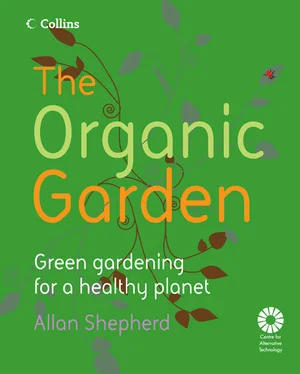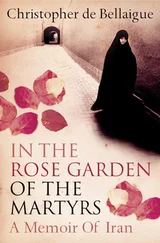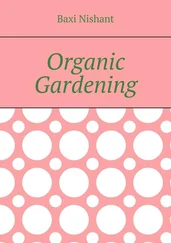Useful websites include www.ethical-junction.org, www.greenguide.co.uk and www.reuze.co.uk.
Buying tools – used or new?
Before you buy anything new go along to a local car boot sale, ask around your mates and check on www.freecycle.org. Don’t buy anything until you’ve exhausted all these secondhand options. Apart from secateurs – which have to be clean and sharp to prevent the spread of plant diseases – and some specialist tools (of which more in a moment), all these tools are just as effective secondhand. Tools need to be rigorous and tough. Check that handles are strong and that the blade or prongs do not bend easily. Some cheap hand forks and trowels bend easily. Press them onto a surface to test them.
There are thousands of unwanted tools cluttering up sheds all over Britain and some companies are getting into the recycling spirit by reclaiming, reconditioning and selling them on. These ‘vintage’ tools are sometimes difficult to get hold of and have special features not normally available. I curse the day I missed an opportunity to buy a reconditioned Victorian daisy grubber from Wales-based group Tools for Self Reliance Cymru ( www.tfsrcymru.org.uk). It was a lovely piece of work that would have made my weeding a lot easier. Buying secondhand tools saves energy and materials and avoids difficult ethical questions about where the tools came from.
In some situations it’s worth buying new. People with back problems or disabilities that prevent them using run-of-the-mill secondhand tools can access good ergonomic tools at www.carryongardening.org.uk, the website of Thrive, an organisation specialising in horticultural therapy. One example is the Swoe cultivator – an extremely useful type of hoe that looks like a golf club. It’s lightweight, but extremely strong and can clear weeds on the backwards and the forwards motion. Turned on its edge it can be used to dig holes for planting, to draw seed drills, and for ridging soil. It is not necessarily designed for people with disabilities but its flexibility and lightness make it a particularly handy tool. The excellently named Lazy Dog Tool Company produce handmade back-saving tools in Yorkshire. Their RIP (removal of individual plants) system keeps bending to a minimum. I also found something called a speed weeder (a small hand tool that enables you to hook weeds out under the root; especially useful for removing weeds from walls and the cracks between paving), which is made in the UK for the Gardeners’ Royal Benevolent Society.
Many new tools are made in developing countries. Most of the time it’s impossible to know in what conditions these tools have been manufactured. It is certainly true to say that health and safety regulations for workers are nowhere near as strong as ours; similarly environmental regulations will be less stringent. Some high-street retailers have made efforts to improve the rights of the workers who supply their tools. B&Q has a long-term goal of transforming the working conditions of suppliers and reducing the environmental impact of their work. If you want to know how good the claims are you need to check out Ethical Consumer magazine’s website www.ethicalconsumer.org.uk.
Most power tools get used for a total of just fifteen minutes in their entire lifetime so cut down on waste by renting from hire shops, borrowing from friends or asking on a swap shop. Of the ten companies investigated by the magazine Ethical Consumer , Draper came out top, followed by The Stanley Works and Makita Corp. and then Black & Decker. The WEEE Directive (Waste Electrical and Electronic Equipment) requires member states of the European Union to set up collection systems for all old electrical equipment by the end of 2006.
One forkfor digging out weeds, turning over soil, lifting plants, forking in compost and manure
One spadefor digging holes, moving soil, making trenches
One rakefor levelling soil ready for planting seeds, removing some lawn weeds, gathering grass clippings, etc
One hoefor removing weeds, marking seed trenches
One hand trowelfor digging small holes and removing some weeds One hand forkfor removing easy-to-lift weeds
One pair of secateursfor light pruning
One small pruning sawfor removing slightly thicker unwanted growth
One pair of scissorsfor cutting flowers, string, etc
One knifefor removing difficult weeds from patios, walls, etc
One sharpening toolfor keeping your cutting tools sharp
Chapter one My space: planning your garden
My granddad detested disorganisation of any sort. He kept all his files in immaculate order and planned everything exceedingly well. If my granddad was writing this book he would expect you to prepare detailed plans of your garden on paper to which you could refer later. And you would need to work out exactly how much spare time you had, and whether or not it was feasible to do the things you wanted to. I am ashamed to say that I have not inherited his sense of order or preparation, I can’t draw and I’m not too good at keeping records. What I can do is appreciate how the seasons change the garden, work out what type of soil I’ve got and what plants I can grow, shape the garden to suit my needs and see that the wildlife get their fair share. None of this is difficult. It just takes time, knowledge and a sense of calm understanding. I tend to keep all the information about my garden in my head and move it around from time to time to come up with the next stage of my slightly baggy long-term development plan. Your impression of a garden changes over time and you learn things that you couldn’t possibly have imagined when you first encountered the space.
Unless you’ve just bought a new-build house, you’ll come into a garden as a small link in a great chain of people who have come before and who will enter after. New-build gardens come without any of the emotional and physical clutter of other people’s plants, sheds, ornaments and rubbish to worry about. If you’re starting work on an old garden, it’s rarely advisable to tear the whole lot down and start again. It takes up more energy, materials, time and money and is not environmentally, financially and emotionally sustainable. Decide what you can live with and work with what you’ve got.
Whether your garden is new or old, it takes a good year to get to know it well enough to really start pulling a plan together. Plants are either sun-loving, shade-tolerant or semi-shade tolerant and the shade cast in your garden will vary from month to month over the whole year (see page 68). You’ll need to learn how other weather conditions such as rain, wind and frost affect the garden (see pages 72–85), because they will all affect plant growth too. If you’re planning to put in fencing, hedging or any structural elements, you’ll need to site them carefully to make the most of these conditions (see page 38). You’ll also need to know what kind of soil you have – clay, sandy, boggy, dry, stony, rich, poor, acid or alkaline – and what sort of plants will grow there (bog-loving, drought-tolerant, acid- or alkaline-loving, and so on). For the sake of clarity I’ve put all this important information in Chapter three.
After about two years of being in my current garden I’ve really started to appreciate all the wildflowers that come up. I haven’t had to do anything to encourage them – just leave them be. In fact, in large parts of my garden I’ve developed a policy of editing what’s there naturally rather than buying and planting seeds. This means digging up those weeds that will become invasive (see pages 190–207) and leaving those wildflowers I know I want. Foxgloves ( Digitalis ), cambrian poppies ( Meconopsis cambrica ) and red campion ( Silene dioica ) are all mainstays in my garden and they’re all fantastic for pollinating insects. They are also resistant to attack from slugs and snails. Editing is a good way to learn about the differences between weeds and wildflowers if you’re just starting to garden.
Читать дальше












